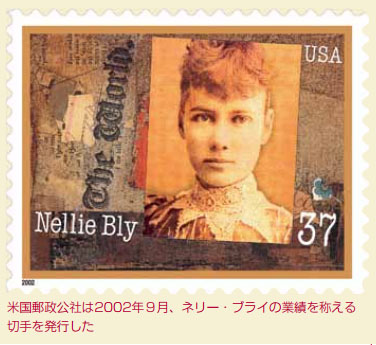国務省出版物
女性実力者の系譜-世界を広げる「ネリー・ブライ(エリザベス・コクラン・シーマン)」
 「米国で最も優秀な記者」*
「米国で最も優秀な記者」*
1864年5月5日生まれ、1922年1月27日死去
エリザベス・コクランは、21歳の時に「ネリー・ブライ」という筆名で記事を書き始め、それまで男性の世界だったジャーナリズムの分野で国際的に知られるようになった。
エリザベス・コクランはペンシルベニア州の小さな町で生まれたが、父親の死後、家族と共にピッツバーグ市に移った。19世紀のフェミニスト運動に反対する記事を読んで怒った彼女は、その筆者を厳しく批判した手紙を「ピッツバーグ・ディスパッチ」紙の編集長に送った。その手紙に強い感銘を受けた編集長はコクランを雇い、彼女は米国における女性記者の先駆けの1人となった。彼女の署名である「ネリー・ブライ」という名前は、スティーブン・フォスターの歌から取ったものである。
ネリー・ブライは、女性を対象とした記事にとどまることなく、男女を問わず一般の市民に注目し、時には彼らの社会に潜入して、その生活や仕事を取材した。工場で働いて、児童労働、危険な職場環境、そして低賃金の実情を実地に観察して記事にしたこともある。彼女の記事の内容に広告主から苦情が出るようになると、上司が記事内容を制限しようとした。ブライはこれに従わず、1886年から87年にかけてメキシコに行き、現地の貧困や汚職についての記事を送った。しかし、この仕事は、メキシコ政府が彼女を国外追放にしたため続かなかった。ブライはピッツバーグに戻ったものの状況に満足できずに別天地を求め、上司に次のようなメモを残した。「ニューヨークへ発ちます。私の活動を期待していてください。ブライ」
1887年、ブライは「ニューヨーク・ワールド」紙の記者となり、汚職や犯罪や虐待を暴露する調査報道(当時は「暴露記事」と呼ばれることが多かった)の先駆者となった。彼女は自ら女子精神病院に入り、退院してから、精神病患者に対するひどい待遇を暴く記事で、「ブラックウェルズ・アイランドの精神病院は、人間をとらえるネズミ捕りだ。入るのはたやすいが、いったん入ったら出てこられない」と書いた。
ブライの生き生きとした描写、勇気ある暴露記事、そしてそうした記事がもたらした数々の改革にもかかわらず、彼女の最も有名な業績は、ジュール・ベルヌの「80日間世界一周」を再現したことである。1889年11月14日、ブライは新聞社の支援の下に、ニューヨークから2万4899マイルの世界一周の旅に出発した。そして、72日6時間11分14秒という新記録で地球を一周し、ニューヨークに帰ってきた。この旅は広く報道され、新聞の読者は毎日彼女の進路を追い、ブライは国際的なセレブリティーとなった。
1895年にブライは裕福な実業家ロバート・シーマンと結婚してジャーナリズムから引退した。シーマンの死後、彼女は夫の事業を維持しようとしたがうまくいかず、1914年には事業の破綻から逃避するためヨーロッパに移り、「ニューヨーク・イブニング・ジャーナル」紙に第1次世界大戦に関する記事を送った。
エリザベス・コクラン・シーマンは、肺炎にかかり57歳で死去した。
*「ニューヨーク・イブニング・ジャーナル」紙による。
*上記の日本語文書は参考のための仮翻訳で、正文は英文です。
Nellie Bly - Women of Influence
"The best reporter in America," says New York Evening Journal
(Born: May 5, 1864; Died: January 27, 1922)
When she was about 21 years old, Elizabeth Cochrane assumed the pen name "Nellie Bly" and wrote her way into worldwide fame in what had been the man's world of journalism.
She was born in a small Pennsylvania town, but her family moved to Pittsburgh after her father's death. An article opposing the goals of the 19th century feminist movement angered Cochrane into sending a stern letter denouncing the writer to the editor of the Pittsburgh Dispatch. The editor was so impressed with her letter that he hired her, making her one of the first women reporters in the United States. Her byline, "Nellie Bly," came from a Stephen Foster song.
Instead of restricting her beat to women's subjects, Nellie Bly focused on ordinary men and women, even going under cover to investigate their lives and jobs. She worked in a factory, for instance, and wrote about child labor, unsafe working conditions, and the poor wages she witnessed first hand. When advertisers began to complain about her stories, her editors tried to restrict her writing. Bly instead traveled to Mexico in 1886-87 and filed stories about the country, describing its poverty and corruption. The assignment ended abruptly when the Mexican government expelled her. Unhappy back in Pittsburgh, Bly decided to try her hand elsewhere. "I am off for New York," said her note to the editors. "Look out for me. Bly."
In 1887, Bly became a reporter for the New York World. There, she pioneered investigative journalism, or, as it was often called, "muckraking" – exposing corruption, crime, and abuse. She had herself committed to a woman's asylum and, once she left, wrote articles that revealed the horrors in the treatment of the mentally ill. "The insane asylum on Blackwell's Island is a human rat trap," Bly concluded. "It is easy to get in, but once there it is impossible to get out."
Despite her vivid writing, her courageous muckraking, and the reforms her articles inspired, Bly is best remembered for mimicking the feat described in Jules Verne's Around the World in 80 Days. With her newspaper's support, she left New York on her 24,899-mile trip on November 14, 1889. She circled the globe, and was back in New York in 72 days, six hours, 11 minutes, and 14 seconds – a new record. The highly publicized trip allowed newspaper readers to follow her travel day by day and made Bly an international celebrity.
Bly retired from journalism in 1895, when she married Robert Seaman, a millionaire industrialist. After his death, she tried unsuccessfully to keep his companies afloat. To escape the collapse of the companies, she left for Europe in 1914, and reported on World War I for the New York Evening Journal.
Elizabeth Cochrane Seaman died at age 57, of pneumonia.
For additional information, see:
Bly, Nellie. Nellie Bly's Book: Around the World in Seventy-Two Days. New York: The Pictorial Weeklies Company, 1890.
http://digital.library.upenn.edu/women/bly/world/world.html
Bly, Nellie. Ten Days in a Mad-House, in Cochrane, Kira, Naomi Wolf, and Eleanor Mills. Journalistas: 100 Years of the Best Writing and Reporting by Women Journalists. New York: Carroll & Graf Publishers: 2005.




